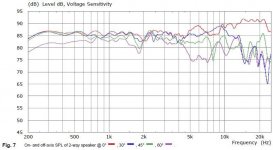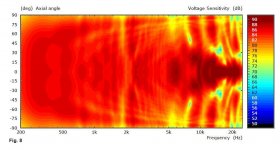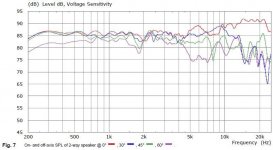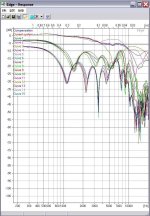In my Carlsson-inspired system the direct sound and the one from the ceiling have about the same amplitude and I know what "bare nakedness of interaural crosstalk" means. When listening to a conventional system I think "What the hell happens when I turn my head? Give me a clamp to fix it!"
Sad that I don't have a Mac to try this:
Download AVS 3D.VR 1.1.0 (Mac)
Converts stereo recordings for a 4*90° quadro setup.
Download AVS 3D.VR 1.1.0 (Mac)
Converts stereo recordings for a 4*90° quadro setup.
Here I agree with Toole.
Recording engineers do it wrong
You are presenting a question: "How could it be any different?" After such a question one has to ponder if you have read Tooles book or not ?Because the answer is there, for sure. It can be different. And it should be different. We can do it differently.
You have a hard time accepting reality, don't you
The solution is better control room standards but this is something you don't want either...
Sad that I don't have a Mac to try this:
Download AVS 3D.VR 1.1.0 (Mac)
Converts stereo recordings for a 4*90° quadro setup.
What kind of processing does it apply?
You can run sophisticated matrix processing on a PC with AcourateConvolver. Please see http://www.diyaudio.com/forums/mult...s-3-speaker-stereo-matrix-15.html#post3405726
The screenshot shows the implementation of a "energy-preserving frequency-dependent" matrix decoder after Gerzon. A detailed description can be found at
http://decoy.iki.fi/dsound/ambisoni...for Multispeaker Stereo (TRIFIELD)_Gerzon.pdf
This is more sophisticated than any other available matrix solution because it employs a bandsplitting filter that is linear phase.
I wasn't able to find a patent from Andrea von Salis, so I can't say anything about the algorithm.
I have a CD with a recording technique by Andrea von Salis where one can have quadro-surroundsound from stereo without processing, just having the rears a few dB down.
Xenakis sappha/Okho/Persephassa: Amazon.de: Musik
sappha/Okho/Persephassa: Amazon.de: Musik
Works best with conventional speakers, and there is no doubt which instruments are behind and which are in front of you.
I have a CD with a recording technique by Andrea von Salis where one can have quadro-surroundsound from stereo without processing, just having the rears a few dB down.
Xenakis
Works best with conventional speakers, and there is no doubt which instruments are behind and which are in front of you.
Elias, that looks like two tweeters and two midtweeters ? in opposing corners.
we should not do that
According to the manual sheet, the 4 tweeters are connected in series-parallel and crossed at 3 kHz. So I am to assume they all reproduce sound above 3 kHz.
Perhaps they were smarter, but we know more now, and one of the things we learned is that you shouldn't sprinkle tweeters all over a baffle.
Is there a reasoning why multible tweeters are not good ? Before answering, let's not forget about the stereo cross talk comb filtering, shall we not
Multible tweeters is actually a remedy in this regard.
Think unconventionally
In my Carlsson-inspired system the direct sound and the one from the ceiling have about the same amplitude and I know what "bare nakedness of interaural crosstalk" means. When listening to a conventional system I think "What the hell happens when I turn my head? Give me a clamp to fix it!"
Exactly. Early room reflections can be used to overcome the negative aspects of cross talk comb filtering. This is also what Toole promotes throughout in his book.
Is there a reasoning why multible tweeters are not good ? Before answering, let's not forget about the stereo cross talk comb filtering, shall we not
Multible tweeters is actually a remedy in this regard.
Think unconventionally
The answer why multiple tweeters are not good is indeed comb filtering. What you create by mounting tweeters at a distance is a complicated lobing pattern. This leads to FR irregularities in the radiation pattern which are unevenly distributed in 3D space.
Why do you think speakers in line arrays need to be as closely spaced as possible?
According to the manual sheet, the 4 tweeters are connected in series-parallel and crossed at 3 kHz. So I am to assume they all reproduce sound above 3 kHz.
Is there a reasoning why multible tweeters are not good ? Before answering, let's not forget about the stereo cross talk comb filtering, shall we not
Multible tweeters is actually a remedy in this regard.
Think unconventionally
I can possibly think they were trying to distribute the frequency band out a bit by using two different types of tweeters and spacing them 'oddly'. Even if crossed at the same frequency. This more common in the days of old, where it was commonly used for baffle diffration loss. Problem with it is that the physical (Mechanical Q) difference between the two driver actually caused more problems than they fixed and thusly is not seem anymore because of increased IM and lagging response interference between the drivers.
I can see the use of multiple tweeters to fix issues as you are thinking could in this case, but certainly not in this manner
The answer why multiple tweeters are not good is indeed comb filtering. What you create by mounting tweeters at a distance is a complicated lobing pattern. This leads to FR irregularities in the radiation pattern which are unevenly distributed in 3D space.
Why do you think speakers in line arrays need to be as closely spaced as possible?
Couldn't have said it better myself
Naim BMR
http://www.naimaudio.com/sites/defa...naim_ovator-s-600_bmr_white-paper_may2009.pdf
Below is the frequency response shown in the white paper, and i assume the data
being rather authentic, because i have seen lots of plots from bending wave
transducers with comparable "gross parameters" due to size, coincidence frequency
etc. The "BMR" does not behave completely different like e.g. the "DDD" type
transducers made by "German Physiks" which are based on the Walsh bending wave
design.
The comment to the measurement is as follows:
"What is more important however is that the on-axis
frequency response curve is no longer an accurate
indicator for the tonality of the loudspeaker. In fact
during the development of the Naim BMR it became
clear that the on-axis response is as good, or bad, as
any other single frequency response measured at any
arbitrary angle."
_______
OK, "according to Toole" we "know" this is not quite true.
The on axis response is of more importance
- or at least needs some closer look - as the off axis responses.
Like other bending wave designs, the BMR tries to achieve a balanced
power response, while "perfectly flat" FR at particular angles is
neither possible nor intended above a certain frequency.
That means you need all the frequency responses to be "complementary"
and they should not change in a too discontinouus manner, for the
speaker to sound uncolored subjectively and have the desired "close to flat"
power response.
The gross behaviour can be described without recurring to the "modal balancing"
technique to detail, since adding mass is just changing the material parameters
of the disc shaped membrane: Bending wave propagation will get slower with
mass added. That means adding mass also affects the coincidence frequency
in certain regions of the disc.
Favouring certain mode shapes over others has a different meaning below the
coincidence frequency than above.
Below coincidence frequency the bending waves propagate slower than sound
in air, at coincidence bending waves and sound in air travel at same speed,
and above coincidence bending waves are faster than sound in air.
Coincidence is due to the fact, that bending waves are dispersive, propagation
speed rises with frequency.
For the radiation this means roughly speaking:
- below coincidence, the "average" membrane speed over area is important.
Thus symmetrical bending modes where regions of same size move in antiphase
will cause a dip in the frequency response and the power response as well.
- at coincidence there is a tendency for a side lobe radiated in direction
of the membranes plane itself: This is called "coincidence hump".
There is less energy radiated on axis and more at <=90 degrees.
- above coincidence also symmetrical modes can radiate effectively, because
pressure gradients in air travel too slow, for (in effect) "averaging" the local
membrane speed over regions moving in antiphase. The "coincidence lobe"
now changes to form a main lobe on axis and several side lobes.
I can identify al least 3 frequency ranges making up this driver's overall response:
a) 0...1,7 Khz "close to pistonic" range
b) 1,7...4Khz "below coincidence modal range"
c) 4..9 Khz "close to coincidence modal range"
d) 9...Khz "above coincidence modal range"
a) The off axis responses correspond closely to the on axis response but
have "low pass filtered" character due to beaming.
b) modal behaviour (center not in phase to outer regions) causes
reduced beaming.
c) When coming closer to coincidence, there radiation gets more angle
dependent again.
d) at about 9Khz there is a coincidence hump with "on axis dip" and pronounced
side lobe: See also Picture 8.
Above that frequency a main lobe forms with "quasi random" side lobes, which
is the typical decorrelated radiation pattern with bending wave transducers above
coincidence frequency. The on axis "main lobe" radiation in this design seems
rather stable however, and also significantly smoother than the off axis radiation
at least above coincidence. Said concidence frequency seems at about 9Khz in
this paricular design which is (i am sorry ...) close to "ultrasonic" for the elder
ones among us and also about 2 octaves above the range of interest, where we
could need decorrelation when aiming at a different "stereophonic approach".
"Modal balancing" IMO is a technique invented for "muddeling through" the
problematic range of low modal density, occuring especially when using
rather small membranes and when using them below coincidence.
It does not produce a behaviour that is different to other bending wave
membranes.
However we discussed, whether this behaviour (decorrelated rediation above
a certain frequency) could yield some benefits due to "outstanding stereo imageing" ...
http://www.naimaudio.com/sites/defa...naim_ovator-s-600_bmr_white-paper_may2009.pdf
Below is the frequency response shown in the white paper, and i assume the data
being rather authentic, because i have seen lots of plots from bending wave
transducers with comparable "gross parameters" due to size, coincidence frequency
etc. The "BMR" does not behave completely different like e.g. the "DDD" type
transducers made by "German Physiks" which are based on the Walsh bending wave
design.
The comment to the measurement is as follows:
"What is more important however is that the on-axis
frequency response curve is no longer an accurate
indicator for the tonality of the loudspeaker. In fact
during the development of the Naim BMR it became
clear that the on-axis response is as good, or bad, as
any other single frequency response measured at any
arbitrary angle."
_______
OK, "according to Toole" we "know" this is not quite true.
The on axis response is of more importance
- or at least needs some closer look - as the off axis responses.
Like other bending wave designs, the BMR tries to achieve a balanced
power response, while "perfectly flat" FR at particular angles is
neither possible nor intended above a certain frequency.
That means you need all the frequency responses to be "complementary"
and they should not change in a too discontinouus manner, for the
speaker to sound uncolored subjectively and have the desired "close to flat"
power response.
The gross behaviour can be described without recurring to the "modal balancing"
technique to detail, since adding mass is just changing the material parameters
of the disc shaped membrane: Bending wave propagation will get slower with
mass added. That means adding mass also affects the coincidence frequency
in certain regions of the disc.
Favouring certain mode shapes over others has a different meaning below the
coincidence frequency than above.
Below coincidence frequency the bending waves propagate slower than sound
in air, at coincidence bending waves and sound in air travel at same speed,
and above coincidence bending waves are faster than sound in air.
Coincidence is due to the fact, that bending waves are dispersive, propagation
speed rises with frequency.
For the radiation this means roughly speaking:
- below coincidence, the "average" membrane speed over area is important.
Thus symmetrical bending modes where regions of same size move in antiphase
will cause a dip in the frequency response and the power response as well.
- at coincidence there is a tendency for a side lobe radiated in direction
of the membranes plane itself: This is called "coincidence hump".
There is less energy radiated on axis and more at <=90 degrees.
- above coincidence also symmetrical modes can radiate effectively, because
pressure gradients in air travel too slow, for (in effect) "averaging" the local
membrane speed over regions moving in antiphase. The "coincidence lobe"
now changes to form a main lobe on axis and several side lobes.
I can identify al least 3 frequency ranges making up this driver's overall response:
a) 0...1,7 Khz "close to pistonic" range
b) 1,7...4Khz "below coincidence modal range"
c) 4..9 Khz "close to coincidence modal range"
d) 9...Khz "above coincidence modal range"
a) The off axis responses correspond closely to the on axis response but
have "low pass filtered" character due to beaming.
b) modal behaviour (center not in phase to outer regions) causes
reduced beaming.
c) When coming closer to coincidence, there radiation gets more angle
dependent again.
d) at about 9Khz there is a coincidence hump with "on axis dip" and pronounced
side lobe: See also Picture 8.
Above that frequency a main lobe forms with "quasi random" side lobes, which
is the typical decorrelated radiation pattern with bending wave transducers above
coincidence frequency. The on axis "main lobe" radiation in this design seems
rather stable however, and also significantly smoother than the off axis radiation
at least above coincidence. Said concidence frequency seems at about 9Khz in
this paricular design which is (i am sorry ...) close to "ultrasonic" for the elder
ones among us and also about 2 octaves above the range of interest, where we
could need decorrelation when aiming at a different "stereophonic approach".
"Modal balancing" IMO is a technique invented for "muddeling through" the
problematic range of low modal density, occuring especially when using
rather small membranes and when using them below coincidence.
It does not produce a behaviour that is different to other bending wave
membranes.
However we discussed, whether this behaviour (decorrelated rediation above
a certain frequency) could yield some benefits due to "outstanding stereo imageing" ...
Attachments
Last edited:
The answer why multiple tweeters are not good is indeed comb filtering. What you create by mounting tweeters at a distance is a complicated lobing pattern. This leads to FR irregularities in the radiation pattern which are unevenly distributed in 3D space.
Why do you think speakers in line arrays need to be as closely spaced as possible?
If you would be listening to 1 speaker, and 1 speaker only, then what you describe makes sense. But we have 2 speakers spaced several meters apart in a stereo triangle. A completely different situation. A huge amount of comb filtering results from the stereo triangle itself, even if the speakers be 'ideal'.
And the line array, it's a one dimensional structure, typically vertical. It does not help here, because we need lateral (horisontal) spatial decorrelation from the speaker. Thus we need a 2 dimensional plane of radiation where the amplitude and phase varies (semi)randomly with lateral angle. Then only the comb filtering from the stereo triangle can be mitigated.
Smearing the time coherenceIf you would be listening to 1 speaker, and 1 speaker only, then what you describe makes sense. But we have 2 speakers spaced several meters apart in a stereo triangle. A completely different situation. A huge amount of comb filtering results from the stereo triangle itself, even if the speakers be 'ideal'.
And the line array, it's a one dimensional structure, typically vertical. It does not help here, because we need lateral (horisontal) spatial decorrelation from the speaker. Thus we need a 2 dimensional plane of radiation where the amplitude and phase varies (semi)randomly with lateral angle. Then only the comb filtering from the stereo triangle can be mitigated.
at the same time as distribution may make it sound better on one front but adds something which we also do not want.
When comparing radiation patterns of (even elaborated and highly
optimized like in the post before)
small disc type bending wave membranes with
possible array configurations using multiple small membranes working
in pistonic manner, the "real bending wave membrane" is rather
unattractive, exept for very lowcost applications maybe.
A smooth on axis response with decorrelated radiation to the sides
can better - and in a more wideband fashion - be provided using
an array.
Otherwise you need much larger and more elaborated bending wave
designs, having (much, much, ...) higher modal density, lower
coincidence frequency etc, ...
Left: Commercial "High End" BMR
Right: Pre- study of a mid-tweeter array at about 0 / 45 / 65 degrees.
- Curves varying with about 8 degrees.
- Level of the 45/65 degrees curves has to be lifted, say according to 200Hz level.
- EQ can be applied easily, e.g. to flatten on axis response.
optimized like in the post before)
small disc type bending wave membranes with
possible array configurations using multiple small membranes working
in pistonic manner, the "real bending wave membrane" is rather
unattractive, exept for very lowcost applications maybe.
A smooth on axis response with decorrelated radiation to the sides
can better - and in a more wideband fashion - be provided using
an array.
Otherwise you need much larger and more elaborated bending wave
designs, having (much, much, ...) higher modal density, lower
coincidence frequency etc, ...
Left: Commercial "High End" BMR
Right: Pre- study of a mid-tweeter array at about 0 / 45 / 65 degrees.
- Curves varying with about 8 degrees.
- Level of the 45/65 degrees curves has to be lifted, say according to 200Hz level.
- EQ can be applied easily, e.g. to flatten on axis response.
Attachments
Last edited:
Smearing the time coherence
at the same time as distribution may make it sound better on one front but adds something which we also do not want.
Stereo triangle smears the time coherence
Stereo triangle adds something we dont want: comb filtering.
Stereo triangle smears the time coherenceFor center panned sound each ear receives the same signal twice by interaural cross talk.
Stereo triangle adds something we dont want: comb filtering.
According to Blumlein stereo works BECAUSE of comb filtering.
Furthermore how would adding more high frequency sources reduce interaural crosstalk?
According to Blumlein stereo works BECAUSE of comb filtering.
Certainly it does not work because of comb filtering

Anyhow Blumlein stereo works only at frequencies where wavelength is much longer than interaural distance. At those freqs there is no comb filtering withing near vicinity of the head. Combing becomes problem at higher freqs.
Furthermore how would adding more high frequency sources reduce interaural crosstalk?
Reduces perception of it.
Maybe it is time for you to read the other half of Tooles book
The matter is universal truth, but since you are a kind of person requesting references, that book is one.
Certainly it does not work because of comb filtering
Anyhow Blumlein stereo works only at frequencies where wavelength is much longer than interaural distance. At those freqs there is no comb filtering withing near vicinity of the head.
Sure there is as the underlying principle is the same: interference.
Combing becomes problem at higher freqs.
Yes it does but there's no practical solution to the problem.
Reduces perception of it.
Nothing more than a hypothesis.
Maybe it is time for you to read the other half of Tooles book
Disrespectful comments like these don't help your case.
Over the weekend I picked up Toole's book (couple of others too) since it is so often mentioned. From everything said tho I do wonder how much I'll learn, to that I mean relearn, as I can't find anything stated (here or in the book) so far that wasn't already accepted. Which I may add is a real kick in the pants, pleased with what was understood decades ago is repeated so often by those we all can respect.
Back to reading...
Back to reading...
Back to reading...
You may discover how often Toole mentions the benefits of early room reflections in mitigating the perception of the comb filtering due to interaural cross talk.
- Status
- This old topic is closed. If you want to reopen this topic, contact a moderator using the "Report Post" button.
- Home
- Loudspeakers
- Multi-Way
- Unconventional Techniques for Achieving Oustanding Stereo Imaging




